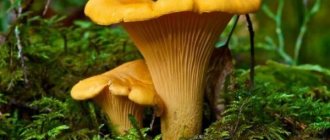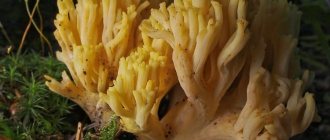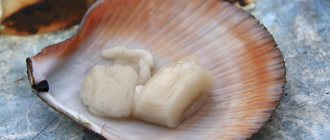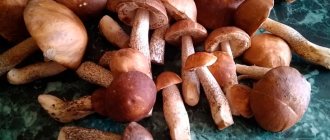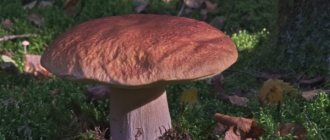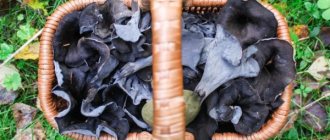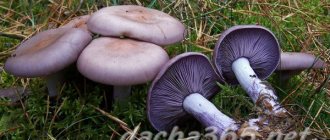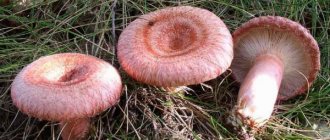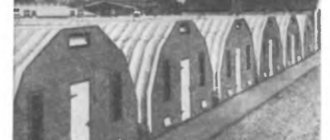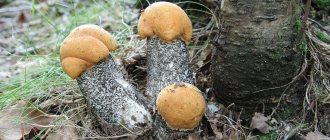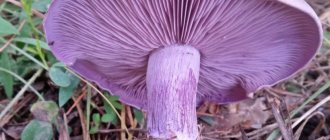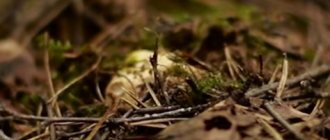Puffball mushrooms belong to the champignon genus. However, due to their peculiar appearance, they are perceived differently from traditional representatives of this family. The surface of the raincoat cap is uneven, covered with slight layers resembling spines or needles. Due to the fact that many spores similar to powder are formed in the mushroom, it is popularly called dust fly, tobacco sponge or tobacco mushroom. Puffballs are often found in forests and grow well in almost any type of soil.
- Warty puffball
- Signs of poisoning from inedible puffballs
- How to cook?
- Compound
Where to find it and in what season?
The puffball mushroom is found in mixed and coniferous forests, on lawns, fields, clearings, forest edges and even in gardens. They grow in groups, but sometimes single specimens sprout. The pear-shaped puffball feels great on rotting trunks of deciduous trees.
Unlike other types of mushrooms, puffballs do not have a stem. The mushroom is a closed ball of white, yellow or brown color. In some species you can see the pseudopod, which is actually part of the body of the fungus. During ripening, the upper part of the cap opens, from which many spores are released. The wind carries spores to near and far areas, so the mushrooms disperse to new places.
In warm regions, raincoats are found already at the end of May. Mushroom pickers usually collect them from July to October. To collect raincoats, it is better to go into the forest on the second day after the rain. The fact is that mushrooms of this species actively absorb water from the soil. Immediately after precipitation falls, raincoats swell and become like jelly.
general description
The cap of most hedgehogs ranges from 3 to 12 centimeters in diameter. However, there are representatives with a hat of 20 centimeters. The lower part of the cap is formed by pointed light needles that are easy to remove. Young mushrooms are distinguished by a convex cap shape, which straightens with age. Some hedgehogs have an irregularly shaped cap. The edges of most species are curved inward.
The pulp of young mushrooms is dense with a pleasant aroma. When mature, it becomes reddish in color.
The leg reaches a length of up to 6 centimeters with a diameter of no more than 2.5 centimeters. The shape of the leg is usually cylindrical with an extension towards the base. The color of the stem is lighter than the cap.
Types of edible puffball mushrooms
Most puffballs are edible. However, there is an important nuance - the mushroom can be eaten while it is white. Young raincoat has a delicate aroma, exquisite taste and delicate structure. After the color change, raincoats are not collected.
Giant
The giant puffball (lat. Langermannia gigantea) is popularly called the big mushroom or gigantic mushroom due to its incredible size. It grows in fields, meadows or deciduous forests. In central Russia, this type of raincoat is rare.
The weight of one such raincoat can reach 8 kg, and the diameter can be up to 50 cm. Externally, the mushroom is a large ball. The shape may be slightly flattened. The skin of the cap is smooth or covered with a flake-like skin. The young mushroom is whitish in color; as it ripens, it becomes dirty green. The structure of the pulp is crumbly and very tender.
Giant raincoat
Pear-shaped
Pear-shaped raincoat (lat. Lycoperdon pyriforme) got its name because of the shape of the fruiting body, similar to a pear. The mushroom can grow up to 4-5 cm, and in the widest part the diameter of the cap can reach 7-9 cm.
The fruiting body of the pear-shaped puffball is covered with a double skin and has a short pseudopod. The outer shell of the young mushroom is leathery, prickly, creamy-white in color, covered with scales and cracks. When the mushroom ages, the thorns fall off, the outer skin cracks, and the inner skin becomes gray-brown or yellow. After this, the inner shell opens, which covers the spores.
The inner fibrous mass of the young puffball is distinctly white, very aromatic, but bland in taste. The harvest time for pear-shaped raincoats is from July to October.
Pear-shaped raincoat
Spiky
The prickly raincoat (lat. Lycoperdon perlatum) is called pearl. Other popular names are more prosaic - needle-shaped, blackberry. The spiny mushroom is not large - it grows up to 4 cm in length and up to 7 cm in diameter. The shape of the raincoat is pear-shaped, slightly flattened.
The fruit body is covered with a spinous or warty shell. Young raincoat is white, becoming gray or purple-brown as it matures. A change in color indicates that the mushroom should not be eaten. The spiny raincoat is harvested from the beginning of July to the first days of September.
Spiky raincoat
Elongated golovach
The oblong golovach (lat. Calvatia excipuliformis) looks like a small ball, pulled together at the bottom. The outer film is smooth at first glance, but if you look closely, you can distinguish small, thin spines. White internal fibers indicate that the mushroom is young. In a mature raincoat they are very dark, almost black.
The oblong golovach can be confused with the false raincoat. The key difference is that the edible mushroom is covered with needles and does not have a pseudopod.
Elongated golovach
Meadow raincoat
Meadow puffball (lat. Vascellum pratense or Lycoperdon pratense) is a mushroom in the shape of a white ball with a wrinkled pseudopod. As the raincoat matures, the outer skin becomes dense and acquires a brown color. The meadow raincoat can be called miniature - its size ranges from 1 to 5 cm in height and diameter.
Meadow mushrooms are collected on open lawns and forest edges. Only young puffballs with snow-white flesh are suitable for food. The inside of ripe mushrooms is brown.
Meadow raincoat
[Video] Useful and healing properties of a raincoat:
Useful qualities
Pearl raincoat is a useful product with a rich chemical composition. The mushroom contains the following components.
| Microelements | Calcium, sodium, phosphorus, potassium, |
| Macronutrients | Iron, zinc, chromium, fluorine, rubidium, molybdenum, iodine |
| Enzymes | Oxidoreductase, amylase, proteinase, lipase |
| Amino acids | Cystine, tryptophan, phenylalanine, methionine |
The product is low-calorie. Nutritional value per 100 g is 27 kcal. At the same time, in every 100 g of mushrooms the amount of protein is 4 g, and fat and carbohydrates are 1 g each, which makes them useful for a vegan diet, in which the body receives few amino acids.
- Spiked raincoat has beneficial effects on the body:
- strengthens the immune system;
- supports thyroid function;
- relieves symptoms of tuberculosis;
- stimulates gastrointestinal functions;
- stabilizes the functioning of the circulatory system;
- prevents lymph stagnation;
- has a diuretic effect.
Inedible species of puffballs
All edible puffballs become unfit for consumption after they change the snow-white color of the fruiting body to some other color. Separately, there are initially inedible types of mushrooms that cannot be eaten regardless of the degree of maturity.
Warty puffball
The warty puffball (lat. Scleroderma verrucosum) is a typical poisonous species, outwardly similar to a yellow-gray potato tuber, the diameter of which does not exceed 5-6 cm. The mushroom has no stem. Over time, the color of the warty raincoat changes to a lighter, brown color, and the outer shell thickens. This type of mushroom is characterized by a peculiar smell of raw potatoes with a spicy, herbal undertone.
Warty puffball
Orange
Orange raincoat (lat. Scleroderma citrinum) is also called ordinary. The mushroom has a tuberous shape and can grow up to 6-7 cm. The leathery shell of the orange puffball is smooth and very dense. The fruit body is brown-yellow in color, covered with small flake-like scales on the crown.
The inner fabric of the orange raincoat is white. As the mushroom ages, its color changes to black, with white fibers appearing. The smell is similar to truffle.
Raincoat orange
Spotted
Spotted puffball (lat. Scleroderma areolatum) or leopard, paternum - a mushroom without a stem, similar in shape to a ball or pear. The size of the fruiting body can range from 1 to 5 cm.
The outer shell of the raincoat is quite thin and does not have any growths. In young mushrooms it is white-cream in color, as it matures it becomes yellowish-brown, covered with small plates with a darker border. The inner fibers are initially white and eventually turn dark, purple or brownish-green. Spotted raincoat has a specific sweetish amber.
Spotted puffball
Which raincoats taste better?
Edible puffballs are eaten while they are young. They then have tasty, dense white flesh, which is located under the skin (smooth or with growths). In an adult mushroom, the pulp changes its quality and color. It becomes looser, often sticky, gray or greenish-yellow. Old mushrooms are filled with spores. The shell of their fruiting body becomes thin, dries and is easily broken. Then the mushroom becomes dusty, releases a cloud of spores and settles on the ground. It is worth saying that raincoats grow up quickly.
As you know, a young raincoat is hard and strong to the touch, and when cut, it is white as sour cream. At this time, you can, without any doubt, put it in the frying pan. The roast will be fragrant with an excellent mushroom aroma. With age, the pulp of the puffball begins to turn slightly yellow, becomes watery, when pressed with a finger, it does not spring back, and does not try to straighten out. At this stage, raincoats should no longer be taken. (V.A. Soloukhin).
Few people find a ripe raincoat appetizing.
How to distinguish edible puffballs from poisonous ones
Every season the number of mushroom pickers in forests and meadows increases. Unfortunately, not all of them have information about the distinctive features of edible and inedible mushrooms. Beginning collectors should carefully study the features of the appearance of raincoats so as not to pay for mistakes.
If you come across suspicious mushrooms that you have no idea about, under no circumstances put them in the basket. For correct identification, use photographs of edible species saved on your phone. There is an opinion that all champignons can be eaten raw. This is partly true - most varieties require pre-treatment.
Edible and non-edible puffballs are similar in shape. They are distinguished by their outer shell. In false mushrooms it is dense, covered with warts or scales, yellow, brown or brown cracks.
The inner pulp of edible mushrooms is tender and can be compared to marshmallows. The smell of such a raincoat is very pleasant, barely perceptible. Inedible varieties are denser and often smell like raw potatoes. In young specimens, the flesh is whitish, lined with a light marble pattern.
Separately, it is worth mentioning the hedgehog puffball - an inedible species, which received its name because of the peculiar spines that make it look like a hedgehog. It is often confused with the brown raincoat. It is the presence of spines that is the main difference. It is impossible to remove or cut them from the mushroom cap, which means it is impossible to cook and eat such a raincoat.
Signs of poisoning from inedible puffballs
Ripe, old puffball mushrooms accumulate harmful compounds, heavy metal salts, and toxins in their own pulp.
Consumption of such mushrooms causes poisoning, the specific symptoms of which are:
- Persistent headaches.
- Loss of consciousness, fainting.
- Nausea, intense vomiting.
- Blueness, pallor of the skin, the appearance of extensive spots with uneven outlines.
- Abdominal pain, severe diarrhea.
This condition is life-threatening and therefore requires immediate medical attention.
False puffball (Scleroderma)
False raincoat (scleroderma) should not be collected. In most books of the Soviet period, this mushroom is considered inedible or poisonous. Western authors only call it inedible, specifying that cooks sometimes add pulp to sausages instead of truffles. They all warn that puffballs can be hazardous to health if eaten in large quantities.
I have not tried this mushroom, so I can only refer to the opinions of authoritative mushroom experts. I quote them verbatim.
The false puffball, which they scare us with in all the books about mushrooms, is not at all poisonous, even in its raw form. It is simply tasteless, and according to the rules it should be classified as an inedible mushroom. Moreover, young false puffball (when the flesh is white when cut) has a sharp, spicy taste and can serve as a piquant seasoning for meat and poultry dishes. This is how it is used in Europe, especially in Slavic countries. The final inedibility of the false puffball occurs from the moment when its flesh ceases to be pure white when cut. (M. Vishnevsky).
Let me remind you once again: false puffballs are poisonous, however, only if you eat them in large quantities. In the Czech guide to mushrooms of J. Klan it is written that “for the sake of a strong spicy taste, young mushrooms are used instead of roots in the preparation of soups and sauces.” These are truly inscrutable human whims! For the sake of an exotic taste, sacrifice the health of your stomach? (M. Sergeeva).
We conclude: the degree of poisoning by false puffballs depends, first of all, on the number of mushrooms eaten.
False puffballs are easy to distinguish from edible species. False puffballs usually have warty-scaly, dense skin of a yellowish-ochre color, which may have small cracks. In older mushrooms, the skin dries out, breaks, and no longer holds the spores underneath.
False raincoats often grow in nests (photo from Wikipedia)
The color of the flesh of young mushrooms, according to most authors, is yellowish or light olive even at a young age. A marble pattern with white veins can be seen on it. The central part of the false puffball darkens as it matures, first becoming gray-violet, then almost black. The pulp of even adult puffballs retains its density. Everyone notes an unpleasant, pungent odor.
Mushroom pickers who have not collected puffballs before should not take risks and not collect mushrooms with elongated false legs that grow in nests. To be on the safe side, it is better not to take raincoats with clearly yellow or brown skin. Especially when it is covered with rough growths and has noticeable cracks. The unpleasant smell should also stop.
Cleaning and processing mushrooms
After collection or purchase, raincoats are thoroughly washed in cool water. Each mushroom is cleaned of soil particles and debris. The outer skin of the fruiting body must be removed. The dense shell can be easily removed with a knife. The peeled mushroom is cut to ensure the integrity of the pulp and the absence of insects. Wormy puffballs are thrown away, small dark wormholes are cut out.
The color of the inner flesh of the puffballs is assessed. Only white mushrooms are eaten. If any shades are recognized, even the most insignificant ones, the raincoat is thrown away. White pulp is a sign of a high-quality mushroom; a changed color of the pulp indicates that it has lost its nutritional qualities and may have acquired poisonous ones.
It is allowed to use raw raincoats for preparing any culinary dishes. This type of mushroom does not need to be boiled or processed in any other thermal way.
Places of distribution and fruiting period
Puffballs grow all over the world, with the exception of cold Antarctica. They prefer to grow in deciduous or coniferous forests, pastures and meadows, grassy meadows and bear fruit from early summer until late autumn.
Puffball puffball loves manured, fertile soil and usually grows in groups. Its mycelium can spread in the soil hundreds of meters around the clearing where the mushroom grows. This is a saprotroph that often settles on plant remains, using fallen leaves and branches as a substrate.
Cooking methods
For cooking, young, fleshy, juicy mushrooms, in which spores have not yet appeared, are used. Raincoats are a healthy, tasty, juicy, safe product if collected on time.
How to cook?
First of all, the raincoats are washed, the outer shell is removed and cut into equal pieces. Place the prepared mushrooms in a saucepan, add water and put on fire. When the water boils, reduce the heat, add salt and spices and boil for about 30 minutes. Puffball goes well with fresh dill, black pepper, and bay leaf.
How to fry?
Raincoats are prepared - washed, peeled, cut into pieces, and placed in a bowl. Next, add salt, spices, breadcrumbs to the mushrooms and mix. Heat butter or vegetable oil in a frying pan and fry the raincoats for 15-20 minutes, depending on the size of the cut. During cooking, stir the mushrooms until golden brown. If desired, raincoats can be fried along with onions and carrots and seasoned with creamy sauce.
How to cook over a fire?
If you want to grill your raincoats over a fire, use a grate. After washing and peeling, the mushrooms are cut into large pieces. Prepared raincoats are rubbed with spices - these can be suneli hops, a mixture of peppers, and herbal spices. Grease the grill with sunflower oil and place the mushrooms in an even layer. Fry the mushrooms on one side until golden brown.
For convenience, you can string pieces of raincoats onto wooden sticks (skewers) soaked in water and place them on the wire rack. This method makes it easy to remove mushrooms from a metal mesh, and is also convenient for eating during a picnic. The sticks are kept in water to prevent them from igniting at the fire.
How to dry it in the oven?
All valuable vitamin and mineral compounds are preserved in dried raincoats. In addition, drying ensures a long shelf life - up to 12 months. Before drying in the oven, the raincoats are washed, peeled from the outer skin and cut into fairly large pieces, since their size decreases during processing.
Cover the baking sheet with baking paper, lay out the mushrooms in one layer and place in the oven, preheated to 50°C. The holding time in the oven is about 3 hours, and the door should be slightly open during the entire drying process. If the mushrooms are very juicy and dry slowly, increase the oven temperature to 60°C.
After the allotted time, take out the baking sheet and place it on the table. You should wait until the dried raincoats cool down. Then the mushrooms are crushed to a powder using a mortar, blender, rolling pin, or simply crumbled by hand. The powder is stored in a glass jar, tightly closed with a lid.
Useful and healing properties
Edible puffball also has medicinal properties. In folk medicine, it is known as a good antitumor agent and is recommended for anemia, eczema, digestive problems and runny nose. A raincoat is also used to stop bleeding and relieve inflammatory processes. It cleanses the body and is used in cosmetology, improving the condition of the skin.
It is interesting that, despite all the advantages of the edible puffball, it is extremely rarely collected. But in vain - for example, in Italy the mushroom is considered delicious. If you decide to try making raincoats, then remember - you cannot store them for a long time, even in the refrigerator - their taste deteriorates very quickly.
